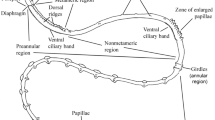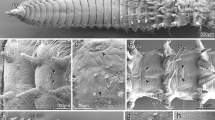Summary
The morphology of cells incorporating modified cilia in the epithelium of the spines, tube-feet and general surface of the ophiuroid echinodermOphiura ophiura are described using transmission and scanning electron microscopy and compared to those on the tube-feet of the echinoidEchinus esculentus. Some receptor cells have cilia showing a normal 9 + 2 microtubular arrangement and these project from the cuticular surface. There are also three basic cell types in which the cilia do not show a continuous normal 9 + 2 microtubular arrangement. In one class, a ring of microvilli form a tube which protrudes from the cuticular surface and which contains a cilium. This type is present on both spines and tube-feet and is identical in structure to the Stäbchen receptors described previously. The second type, termed the non-projecting receptor, is not surrounded by specialized microvilli, and the cilium which projects from the receptor cell ends flush with the cuticle which may be 3 or 4 μm above the epithelial surface; these are only present on the tube-feet. The third type of receptor occurs on the general surface of the arm, and from its position and some aspects of its structure may be a general photic receptor. It consists of a highly modified cilium characterized by a very short ciliary root. The cilium projects very little above the receptor cell surface and terminates among the extracellular fibrillar material that packs the gap of variable width between the epithelial cellular surface and the non-cellular cuticle. The distribution of these presumptive receptor cells is discussed in the light of recent sensory physiological findings and previous descriptions by other authors of receptor structures in the whole phylum.
Similar content being viewed by others
References
Barker, M. F. (1978) Structure of the organs of attachment of brachiolaria larvae ofStichaster australis (Verrill) andCoscinasterias calamaria (Gray).Journal of Experimental Marine Biology and Ecology 33, 1–36.
Bouland, C., Massin, C. &Jangoux, M. (1982) The fine structure of the buccal tentacles ofHolothuria forskali.Zoomorphology 101, 133–49.
Brehm, P. H. (1975) Bioluminescence: the anatomy and physiology of its nervous control in Ophiopsila californica. PhD Thesis, University of California.
Burke, R. D. (1978) The structure of the nervous system of the pluteus larva ofStrongylocentrotus purpuratus.Cell and Tissue Research 191, 233–47.
Burke, R. D. (1980) Podial sensory receptors and the induction of metamorphosis in echinoids.Journal of Experimental Marine Biology and Ecology 47, 223–34.
Burke, R. D. (1983) The structure of the larval nervous system ofPisaster ochraceus.Journal of Morphology 178, 23–35.
Byrne, M. &Fontaine, A. R. (1983) Morphology and function of the tubefeet ofFlorometra serratissima.Zoomorphology 102, 175–87.
Campbell, A. C. (1983) Form and function of pedicellariae. InEchinoderm Studies, Vol. 1 (edited byJangoux, M. &Lawrence, J. M.), pp. 139–67. Rotterdam: Balkema.
Cobb, J. L. S. (1968) The fine structure of the pedicellariae ofEchinus esculentus. II. The sensory system.Journal of the Royal Microscopical Society 88, 223–33.
Cobb, J. L. S. (1985) The neurobiology of the ectoneural/ hyponeural synaptic Connection in an echinoderm.Biological Bulletin 168, 432–46.
Cobb, J. L. S. &Stubbs, T. (1981) The giant neurone system in ophiuroids. I. The general morphology of the radial nerve cords and circumoral ring.Cell and Tissue Research 219, 197–207.
De Vos, L. (1985) Ultrastructure of tubefeet of the ophiuroidAmphipholis squamata. InProceedings of 5th International Echinoderms Conference (edited byKeegan, B. F.). Rotterdam: Balkema.
Dietrich, H. F. &Fontaine, A. R. (1975) A decalcification method for ultrastructure of echinoderm tissue.Stain Technology 50, 351–4.
Eakin, R. M. (1966) Evolution of photoreceptors.Cold Spring Harbor Symposia on Quantitative Biology 30, 363–70.
Fankboner, P. V. (1978) Suspension-feeding mechanisms of the armoured sea cucumberPsolus chitinoides.Journal of Experimental Marine Biology and Ecology 31, 11–25.
Florey, E. &Cahill, M. A. (1982) Scanning electron microscopy of echinoid podia.Cell and Tissue Research 224, 543–51.
Green, C. R., Bergquist, P. R. &Bullivant, S. (1979) An anastomosing septate junction in endothelial cells of the phylum Echinodermata.Journal of Ultrastructure Research 67, 72–80.
Holland, N. D. &Nealson, K. H. (1978) The fine structure of the echinoderm cuticle and the subcuticular bacteria of echinoderms.Acta zoologica 59, 169–85.
Holley, M. C. (1984) The ciliary basal apparatus is adapted to the structure and mechanics of the epithelium.Tissue and Cell 16, 287–310.
Martinez, J. L. (1977) Estructura y ultraestructura del epitelio de los podios deOphiothrix fragilis.Real Sociedad Espanola de Historia Natural 75, 275–301.
Moore, A. &Cobb, J. L. S. (1985a) Neurophysiological studies on photic responses inOphiura ophiura.Comparative Biochemistry and Physiology 80A, 11–16.
Moore, A. &Cobb, J. L. S. (1985b) Neurophysiological studies on the detection of amino acids byOphiura ophiura.Comparative Biochemistry and Physiology 82A, 395–9.
Oldfield, S. C. (1975) Surface fine structure of the globiferous pedicellariae of the regular echinoid,Psammechinus miliaris.Cell and Tissue Research 162, 377–85.
Penn, P. E. &Alexander, P. E. (1980) Fine structure of the optic cushion in the asteroidNepanthia belcheri.Marine Biology 58, 251–6.
Reichensperger, A. (1908) Die Drüsengelbilde der Ophiuren.Zeitschrift Wiss Zoologie 91, 304–50.
Sloan, N. A. &Campbell, A. C. (1982) Chemoreception. InEchinoderm Nutrition (edited byJangoux, M. &Lawrence, J. M.), pp. 1–22. Rotterdam: Balkema.
Souza Santos, H. (1966) The ultrastructure of the mucous granules from starfish tubefeet.Journal of Ultrastructure Research 16, 259–68.
Strathmann, R. R. (1972) The feeding behaviour of planktotrophic echinoderm larvae: mechanisms, regulation and rates of suspension-feeding.Journal of Experimental Marine Biology and Ecology 6, 109–60.
Stubbs, T. &Cobb, J. L. S. (1982) A new ciliary feeding structure in an ophiuroid echinoderm.Tissue and Cell 14, 573–83.
Weber, W. &Grosmann, M. (1977) Ultrastructure of the basiepithelial nerve plexus of the sea urchinCentrostephanus longispinus.Cell and Tissue Research 175, 551–62.
Whitfield, P. J. &Emson, R. H. (1983) Presumptive ciliated receptors associated with the fibrillar glands of the spines of the echinodermAmphipholis squamata.Cell and Tissue Research 232, 609–24.
Wood, R. L. &Cavey, M. J. (1981) Ultrastructure of the coelomic lining in the podium of the starfishStylasterias forreri.Cell and Tissue Research 218, 449–73.
Author information
Authors and Affiliations
Rights and permissions
About this article
Cite this article
Cobb, J.L.S., Moore, A. Comparative studies on receptor structure in the brittlestarOphiura ophiura . J Neurocytol 15, 97–108 (1986). https://doi.org/10.1007/BF02057908
Received:
Revised:
Accepted:
Issue Date:
DOI: https://doi.org/10.1007/BF02057908




